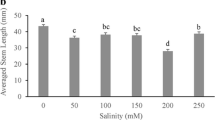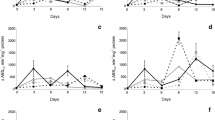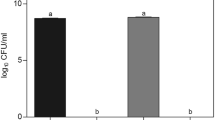Abstract
Inoculation of wheat seedlings with the plant growth-promoting bacterium Azospirillum brasilense Cd was immobilized in alginate microbeads and, without applying any stress, significantly increased the quantity of several photosynthetic pigments, such as chlorophyll a, chlorophyll b, and the auxiliary photoprotective pigments violaxanthin, zeaxanthin, antheroxanthin, lutein, neoxanthin, and β-carotene. This resulted in greener plants with no apparent visible stress. After monitoring the quantity of photosynthetic pigments for 4 weeks, we observed that inoculated plants had higher quantities of pigments in shoot and stem. The greatest difference in the quantity of all pigments between inoculated and noninoculated plants occurred in the first week of growth. Regardless of treatment, the quantity of pigments in stems was three to four times less than the quantity of these pigments in shoots. Application of Azospirillum, either as liquid inoculant or as alginate microbeads, did not alter the positive effect of the bacteria on pigment production or the positive response of the plants towards A. brasilense Cd inoculation.


Similar content being viewed by others
References
Alam MS, Cui ZJ, Yamagishi T, Ishii R (2001) Grain yield and related physiological characteristics of rice plants (Oryza sativa L.) inoculated with free-living rhizobacteria. Plant Prod Sci 4:126–130
Amir HG, Shamsuddin ZH, Halimi MS, Ramlan MF, Marziah M (2001) Effects of Azospirillum inoculation on N2 fixation and growth of oil palm plantlets at nursery stage. J Oil Palm Res 13:42–49
Bacilio M, Rodriguez H, Moreno M, Hernandez J-P, Bashan Y (2004) Mitigation of salt stress in wheat seedlings by a gfp-tagged Azospirillum lipoferum. Biol Fertil Soils 40:188–193
Bambal AS, Verma RM, Panchbhai DM, Mahorkar VK, Khankhane RN (1998) Effect of biofertilizers and nitrogen levels on growth and yield of cauliflower (Brassica oleracea var. botrytis). Orissa J Hort 26:14–17
Bashan Y (1986) Significance of timing and level of inoculation with rhizosphere bacteria on wheat plants. Soil Biol Biochem 18:297–301
Bashan Y (1998) Azospirillum plant growth-promoting strains are nonpathogenic on tomato, pepper, cotton, and wheat. Can J Microbiol 44:168–174
Bashan Y, de-Bashan LE (2005) Fresh-weight measurements of roots provide inaccurate estimates of the effects of plant growth-promoting bacteria on root growth: a critical examination. Soil Biol Biochem 37:1795–1804
Bashan Y, Dubrovsky JG (1996) Azospirillum spp. participation in dry matter partitioning in grasses at the whole plant level. Biol Fertil Soils 23:435–440
Bashan Y, Holguin G (1997) Azospirillum–plant relationships: environmental and physiological advances (1990–1996). Can J Microbiol 43:103–121
Bashan Y, Levanony H (1990) Current status of Azospirillum inoculation technology: Azospirillum as a challenge for agriculture. Can J Microbiol 36:591–608
Bashan Y, Holguin G, Lifshitz R (1993) Isolation and characterization of plant growth-promoting rhizobacteria. In: Glick BR, Thompson JE (eds) Methods in plant molecular biology and biotechnology. CRC Press, Boca Raton, FL, pp 331–345
Bashan Y, Davis EA, Carrillo-Garcia A, Linderman RG (2000) Assessment of VA mycorrhizal inoculum potential in relation to the establishment of cactus seedlings under mesquite nurse-trees in the Sonoran desert. Appl Soil Ecol 14:165–176
Bashan Y, Hernandez J-P, Leyva LA, Bacilio M (2002) Alginate microbeads as inoculant carrier for plant growth-promoting bacteria. Biol Fertil Soils 35:359–368
Bashan Y, Holguin G, de-Bashan LE (2004) Azospirillum–plant relationships: physiological, molecular, agricultural, and environmental advances (1997–2003). Can J Microbiol 50:521–577
Carrillo-Garcia A, Leon de la Luz J-L, Bashan Y, Bethlenfalvay GJ (1999) Nurse plants, mycorrhizae, and plant establishment in a disturbed area of the Sonoran Desert. Restor Ecol 7:321–335
Carrillo-Gracia A, Bashan Y, Diaz-Rivera E, Bethlenfalvay GJ (2000) Effects of resource—island soils, competition, and inoculation with Azospirillum on survival and growth of Pachycereus pringlei, the giant cactus of the Sonoran Desert. Restor Ecol 8:65–73
Choudhury NK, Choe HT (1996) Photoprotective effect of kinetin on pigment content and photochemical activities of wheat chloroplasts aging in vitro. Biol Plant 38:61–69
Choudhury NK, Aslam M, Huffaker RC (1994) Photochemical activities in wheat chloroplast incubated under irradiation and possible photoprotection by zeaxanthin. Photosyntetica 30:397–405
Choudhury NK, Choe HT, Huffaker RC (1996) Ascorbate induced zeaxanthin formation in wheat leaves and photoprotection of pigments and photochemical activities during aging of chloroplasts in light. J Plant Physiol 141:551–556
de-Bashan LE, Bashan Y, Moreno M, Lebsky VK, Bustillos JJ (2002) Increased pigment and lipid content, lipid variety, and cell and population size of the microalgae Chlorella spp. when co-immobilized in alginate beads with the microalgae-growth-promoting bacterium Azospirillum brasilenses. Can J Microbiol 48:514–521
Deka BHP, Dileep KBS (2002) Plant disease suppression and growth promotion by a fluorescent Pseudomonas strain. Folia Microbiol 47:137–143
Demmig-Adams B (1990) Carotenoids and photoprotection in plants: a role for the xanthophylls zeaxanthin. Biochim Biophys Acta 1020:1–24
Elanchezhian R, Panwar JDS (1997) Effects of 2,4-D and Azospirillum brasilense on nitrogen fixation, photosynthesis and grain yield in wheat. J Agron Crop Sci 178:129–133
Falbel TG, Staehelin LA, Adams WW III (1994) Analysis of xanthophylls cycle carotenoids and chlorophyll fluorescence in light-intensity dependent chlorophyll-deficient mutant of wheat and barley. Photosynthesis Res 42:191–202
Gonzalez LE, Bashan Y (2000) Increased growth of the microalga Chlorella vulgaris when coimmobilized and cocultured in alginate beads with the plant growth-promoting bacterium Azospirillum brasilense. Appl Environ Microbiol 66:1527–1531
Lidon FC, Loureiro AS, Vieira DE, Bilho EA, Nobre P, Costa R (2001) Photoinhibition in chilling stressed wheat and maize. Photosynthetica 39:161–166
Loggini B, Scartazza A, Brugnoli E, Navari-Izzo F (1999) Antioxidative defense system, pigment composition, and photosynthetic efficiency in two wheat cultivars subjected to drought. Plant Physiol 119:1091–1099
Lu CM, Lu QT, Zhang J, Kuang TY (2001) Characterization of photosynthetic pigment composition, photosystem II photochemistry and thermal energy dissipation during leaf senescence of wheat plants grown in the field. J Exp Bot 52:1805–1810
Malek W (1996) Alnus incana response on treatment with fluorescent Pseudomonas sp. strain-267. J Basic Microbiol 36:327–333
Mantoura RFC, Repeta D (1997) Calibration methods for HPLC. In: Jeffrey SW, Mantoura RFC, Wright SW (eds) Phytoplankton pigments in oceanography: guidelines to modern methods. Monographs on oceanographic methodology, vol. 10. UNESCO Publishing, Paris, pp 407–428
Omar MNA, Fang P, Jia XM (2000) Effect of inoculation with Azospirillum brasilense NO40 isolated from Egyptian soils on rice growth in China. Egypt J Agric Res 78:1005–1014
Panwar JDS (1991) Effect of VAM and Azospirillum brasilense on photosynthesis nitrogen metabolism and grain yield in wheat. Indian J Plant Physiol 34:357–361
Panwar JDS (1992) Effect of VAM and Azospirillum inoculation on metabolic changes and grain yield of wheat under moisture stress condition. Indian J Plant Physiol 35:157–161
Panwar JDS, Singh O (2000) Response of Azospirillum and Bacillus on growth and yield of wheat under field conditions. Indian J Plant Physiol 5:108–110
Pfuldel E, Bilder W (1994) Regulation and possible function of the violaxanthin cycle. Photosynthesis Res 42:89–109
Porra RJ, Pfundel EE, Engel N (1997) Metabolism and function of photosynthetic pigments. In: Jeffrey SW, Mantoura RFC, Wright SW (eds) Phytoplankton pigments in oceanography: guidelines to modern methods. Monographs on oceanographic methodology. UNESCO Publishing, Paris 10, pp 85–126
Puente M-E, Bashan Y (1993) Effect of inoculation with Azospirillum brasilense strains on the germination and seedlings growth of the giant columnar Cardon cactus (Pachycereus pringlei). Symbiosis 15:49–60
Sharma A, Johri BN, Sharma AK, Glick BR (2003) Plant growth-promoting bacterium Pseudomonas sp. strain GRP SUB 3 influences iron acquisition in mung bean (Vigna radiata L. Wilzeck). Soil Biol Biochem 35:887–894
Singh O, Panwar JDS (1997) Effect of nitrogen fixing and phosphorus solubilising bacteria on nutrient uptake and yield of wheat. Indian J Plant Physiol 2:211–213
Swedrzynska D, Sawicka A (2000) Effect of inoculation with Azospirillum brasilense on development and yielding of maize (Zea mays ssp. saccharata L.) under different cultivation conditions. Pol J Environ Stud 9:505–509
Tambussi EA, Casadesus J, Munne-Bosch S, Araus JL (2002) Photoprotection in water-stressed plants of durum wheat (Triticum turgidum var durum): changes in chlorophyll fluorescence, spectral signature and photosynthetic pigments. Funct Plant Biol 29:35–44
Tsimilli-Michael M, Eggenberg P, Biro B, Koves-Pechy K, Voros I, Strasser RJ (2000) Synergistic and antagonistic effects of arbuscular mycorrhizal fungi and Azospirillum and Rhizobium nitrogen-fixers on the photosynthetic activity of alfalfa, probed by the polyphasic chlorophyll a fluorescence transient O-J-I-P. Appl Soil Ecol 15:169–182
Xu CC, Li DQ, Zou Q, Zhang JH (1999) Effect of drought on chlorophyll fluorescence and xanthophylls cycle components in winter wheat leaves with different ages. Acta Phytophysiol Sinica 25:29–37
Xu CC, Li LB, Kuang TY (2000) Photoprotection in chilling-sensitive and resistant plants illuminated at the chilling temperature: role of the xanthophylls cycle in the protection against lumen acidification. Aust J Plant Physiol 27:669–675
Acknowledgements
Yoav Bashan participated in this study in memory of the late Messrs. Avner and Uzi Bashan from Israel. We thank Francisco Hernandez of CIBNOR for HPLC analysis of pigments and the staff editor for improving the English text. This study was partially supported by The National Council of Science and Technology of Mexico (CONACYT contract U39520-Z) and The Bashan Foundation, USA.
Author information
Authors and Affiliations
Corresponding author
Rights and permissions
About this article
Cite this article
Bashan, Y., Bustillos, J.J., Leyva, L.A. et al. Increase in auxiliary photoprotective photosynthetic pigments in wheat seedlings induced by Azospirillum brasilense . Biol Fertil Soils 42, 279–285 (2006). https://doi.org/10.1007/s00374-005-0025-x
Received:
Revised:
Accepted:
Published:
Issue Date:
DOI: https://doi.org/10.1007/s00374-005-0025-x




